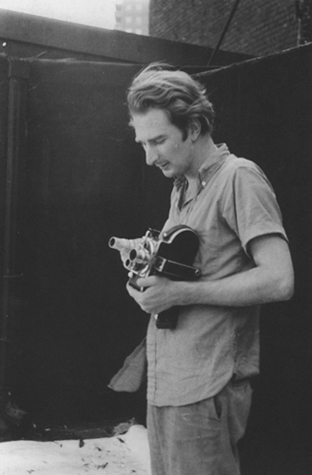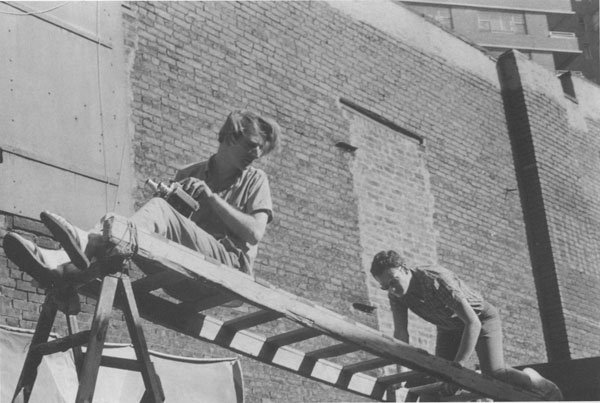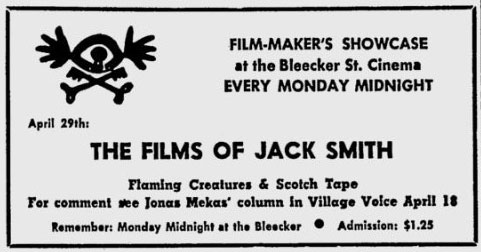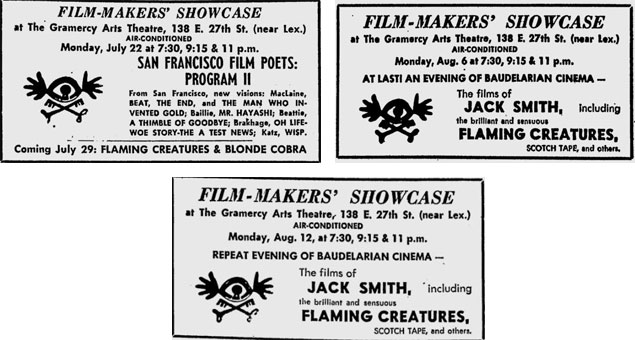Jack Smith
Gary Comenas (2007/rev. 2015)

Jack Smith during the filming of Flaming Creatures
(Photo: Norman Solomon)
Andy Warhol | Ken Jacobs | The Beautiful Book | Flaming Creatures Ron Rice | Marijuana | Expanded Cinema | Aspen by Warhol | Plaster | Robert Wilson | Ronald DeCarlo | The Penguin | The End |
Congressional Record (Sept. 4, 1968):
Jack Smith's film Flaming Creatures presents five unrelated badly filmed sequences... a mass rape scene involving two females and many males which lasts for 7 minutes, showing the female pubic area, the male penis, male massaging the female vagina and breasts, cunnilingus, masturbation of the male organ... lesbian activity between two women... homosexual acts between a man dressed as a female, who emerges from a casket, and other males, including masturbation of the visible male organ... homosexuals dancing together and other disconnected erotic activity, such as massaging the female breasts and group sexual activity. (JS165)
Jack Smith was born on November 14, 1932 in Columbus Ohio to Alvin J. Smith of West Virginia and Chrystine Mayo of Hazelton, Pennsylvania. When he was seven his father died in a fish boating accident off the Gulf Coast after his family had moved to Texas. Jack, his sister and mother lived in trailer parks until his mother remarried in approximately 1945 and the family moved to Wisconsin. When he graduated from high school in Kenosha, his parents gave him his first movie camera (8mm), which was stolen from him shortly thereafter. He left home and moved to Chicago in 1951 and then to Los Angeles in 1952 where he begun making a 16mm film later titled Buzzards Over Baghdad. He moved to New York the following year, in 1953, where he worked as an office boy and took film classes at the City College of New York.
In Popism, Andy Warhol, (via Pat Hackett), credits Jack Smith with being an influence on his own filmmaking - "the way he used anyone who happened to be around that day, and also how he just kept shooting until the actors got bored." (POP31)Warhol also used many of Smith's actors in his own films, including Mario Montez, Frances Francine, Naomi Levine, Tally Brown as well as Jack Smith, himself.
Warhol's earliest film footage was shot in Old Lyme, Connecticut, including footage of Jack Smith filming Normal Love. Although the Old Lyme property was referred to as "Eleanor Ward's property" in Popism, it actually belonged to a couple of nudist Buddhists according to Wynn Chamberlain who was renting part of the property from them.
Wynn Chamberlain:
"For five summers I rented a farm house and studio barn from the Malletts, wonderful old Buddhist nudists. Then in 1963 Eleanor showed up, rented the chicken coop and destroyed the peace. She co-opted the Ice House for her guest house, planted a lawn over an old driveway and infuriated the Malletts by trying to take over the whole place. So you can imagine how irritated I get when people talk about the summer of 1963 and Eleanor Ward's property in Old Lyme." (See "Wynn Chamberlain.")
Chamberlain also claimed that Warhol's early footage was shot with a movie camera belonging to the father of his girlfriend (later his wife), Sally. According to Wynn, Sally "brought her father's 1929 Bolex with her to record Jack Smith filming Normal Love, Andy borrowed it and thus began his movie career." Wynn notes that the Bolex "never worked again after that weekend)
In addition to the Old Lyme footage, Warhol films that feature Jack Smith in the the cast include Batman Dracula aka Dracula, Camp and Hedy.
Jack Smith had become involved in the underground film scene after moving to New York in 1953. While taking film classes at the City College of New York he met the then aspiring filmmaker Bob Fleischner who then introduced Smith to Ken Jacobs. Jack appeared in two Ken Jacobs 16mm films in 1957 and throughout 1958 and in 1959 Jacobs filmed Smith for Jacobs' unfinished epic Star Spangled to Death and its "edited in the camera" spinoff, Little Stabs at Happiness. (JS158)
Smith had also collaborated on an abandoned film project with Bob Fleischner in early 1959 which was edited by Ken Jacobs the following year into a portrait of Smith called Blonde Cobra. Smith also used Jacobs' Bell and Howell movie camera to make Scotch Tape in 1959 - a short one reel color film shot at the "rubble strewn site of the future Lincoln Center." He followed this up with a longer black and white film, Overstimulated shot in his Lower East Side apartment featuring Fleischner and Jerry Sims wearing "long, filmy dresses and jumping up and down in front of flickering television set." (JS158)
Ken Jacobs and Smith had a falling out after their last film together The Death of P Town during the summer of 1961. In the film - which was shot in a cemetery - Smith played a vampire fairy, just as he would later play the part of the vampire Dracula in Warhol's later film Batman Dracula.
In addition to appearing in and making films, Smith was also doing photographic work, opening the Hyperbole Photography Studio in a storefront on Eighth Street near Cooper Union in 1957. Lawrence Rinder, the 20th century art curator at the Berkeley Art Museum compared Smith's studio to that of Claes Oldenburg: "Like Claes Oldenburg's The Store which opened nearby in 1961, Smith's studio was less a commercial enterprise than a kind of ongoing performance/installation." (JS139)
Smith's first one-person photography exhibit was at the Limelight Gallery in 1960 - "one of the most prestigious photographic venues at the time, where such luminaries as Eugene Atget, Berenice Abbott, Henri-Cartier Bresson, Ansel Adams and Paul Strand were regularly exhibited." (PS143) The press release for the exhibit described Smith's photographs as "close-up exaggerations of mysterious-looking faces, trappings that smack of Moroccan motifs, exotic juxtapositions of figures and gestures surrounded by drapes and debris, all in particular and unnatural casts of color." (JS151)
In late 1962 Smith produced The Beautiful Book published by the poet (and filmmaker) Piero Heliczer's Dead Language Press in a limited edition of 200 copies. The Beautiful Book consisted of nineteen "tipped-in black and white photographs" and included photos of future Warhol stars Mario Montez and Frances Francine. (JS143) Smith called his models "Superstars of Cinemaroc" with Cinemaroc being the name he gave to his imagined film studio. Ronald Tavel and Louis Waldon also featured in some of Smith's other photographic work.
Irving Rosenthal: "Jack's shooting sessions were transformative. He was a transformer of people who got the artistic effects that he got because he had the power of transforming, like a guru. Yes, he was creating works of art... some of us at the shooting sessions understood that. But others came just because of his transformative power. The sessions were extremely arduous. Jack was always after the essence of his models. Kind of like a shrink. People would sometimes leave crying. You couldn't trust him. He was very cruel." (JS144)
The cover design for The Beautiful Book was based on a sketch by artist Marian Zazeela. Smith had met Zazeela in the autumn of 1961 through Irving Rosenthal. Smith's controversial film Flaming Creatures was originally conceived as a vehicle for Zazeela. However, Zazeela was in a relationship with La Monte Young at the time which left her with little time for filming so she was replaced with Sheila Bick - although Zazeela did appear very briefly in the film.
Jack Smith's film Flaming Creatures would eventually become embroiled in a major censorship battle which would involve the United States Congress and the U.S. Supreme Court (not to mention making the front page of Variety).
Flaming Creatures was shot during the summer and autumn of 1962 on the roof of the Windsor Theater in New York City. Tony Conrad who did the film's soundtrack recalls the filming: "There were lots of weird substances being consumed and strange people arriving on the scene... And boy, was I surprised when it turned out that people took three hours to put on their makeup; I was very more surprised when people took several more hours to put on their costumes." Smith gave Conrad a dress to wear and, Conrad remembers that Smith then "ripped it down the back to expose my ass and turned my back to the camera." (JS159)
Also participating in the film were future Warhol stars Francis Francine and Mario Montez. Flaming Creature Jack Smith: His Amazing Life and Times (London: Serpent's Tail, 1997), mentions that Warhol's script writer, Ronald Tavel, also participated in the production. The publication says that Ron was "crouched on the catwalk pouring plaster dust on the actors while Smith filmed the rape-earthquake- orgy..."
Norman R. Glick has pointed out that it was Harvey, not Ron Tavel, who was pouring the dust. Glick was Harvey's long-time partner - they were married on 20 October 2009 in a ceremony at Harvey Feinstein's home in Connecticut. According to Glick, the claim that Ron was pouring the dust was "another instance of my dear Harvey being eclipsed by his brother."
Norman R. Glick:
"It was Harvey who got up on the ladder with Jack suspended above and between the action and the camera. Ronald would not have the balls to do that. I only learned of this by getting my hands on the J. Oberman book about Jack called Flaming Creatures, which had some black and white tri-ex pan film that was shot during the 'creation of the earthquake (plaster fragments being tossed onto the roof from above).' In those I got to see the comely Harvey I fell in love with, 50 years ago, up there with Jack. He said that he mentioned to Jack he only had big pieces left, and Jack said 'toss them too!!'
I can't believe that film was made, with the enormous amount of hallucinogens consumed over many hours. I was not allowed to go up to that shoot. Ronald was his usual paranoid self, as I was still a minor, he would not permit me. When I turned 18 and later 21, Harvey told me years later how relieved Ronald was." (Email 21 November 2014)

Jack Smith and Harvey Tavel on the set of Flaming Creatures
(J. Hoberman, On Jack Smith's Flaming Creatures and
Other Secret-Flix of Cinemaroc (NY: Hips Road, 2001)
Another participant, Joan Adler, remembers that the orgy was shot "in broiling sunlight with the set falling all over, [the performers] high as kites, Jack pouring ceiling plaster all over them... and careening dangerously above on some swinging homemade contraption." (JS160)
Smith screened unfinished footage from Flaming Creatures for his friends throughout the winter of 1962/63. It was also shown at a publicized benefit organized by poet Piero Heliczer's Dead Language Press at the loft of painter Jerry Joffen on West 20th Street - which also had a reputation as a shooting gallery for junkies. During this showing, the movie was accompanied by Taylor Mead playing a violin. (JS161) Mead regretted not being in the film:
Taylor Mead:
"I was supposed to be in Flaming Creatures but I already had my Flower Thief image... and I heard there was nudity in Flaming Creatures, so I thought 'well, I have this image'. I was like a young actor 'I have this image I must maintain', you know. So I goofed on not being in Flaming Creatures, which was such a great film, but Jack did once have me playing the violin in front of the screen until the audience began objecting." (NL84)
The theatrical premiere of Flaming Creatures took place on April 29, 1963 at midnight at the Bleecker Street Cinema (JH37):

Village Voice ad, 25 April 1963
The ad referred readers to Mekas' comments in the April 18th Village Voice:
Jonas Mekas ("Movie Journal," The Village Voice, 18 April 1963, p. 13):
Jack Smith just finished a great movie, Flaming Creatures, which is so beautiful that I feel ashamed even to sit through the current Hollywood and European movies. I saw it privately, and there is little hope that Smith's movie will ever reach the movie theatre screens. But I tell you, it is a most luxurious outpouring of imagination, of imagery, of poetry, of movie artistry, comparable only to the work of the greatest , like Von Sternberg.
Flaming Creatures will not be shown theatrically because our social-moral-etc. guides are sick. That's why Lenny Bruce cried at Idlewild Airport. This movie will be called pornographic, degenerate, homosexual, trite, disgusting, etc., home movie. It is all that, and it is so much more than that."
Mekas continued to show the film at the Gramercy Arts Theatre after he moved his operation there from the Bleecker Street Cinema. Screenings were announced for July 29th, August 6th and August 12th in Village Voice ads.

Village Voice ads announcing screenings of Flaming Creatures
at the Gramercy Arts Theatre
Top (L to R): 18 July, 1963 and 1 August 1963/Bottom: 8 August 1963
According to film writer J. Hoberman, "... police harassment had become a regular feature of the show. Because the films exhibited were not submitted to the New York State Board of Regents for licensing, it was deemed illegal to charge admission for their exhibition. Mekas' counter-strategy was to present the movies free and solicit contributions for the Love and Kisses to Censors Film Society." (JH39)
On December 7th Jonas Mekas was scheduled to present Smith with Film Culture magazine's annual Independent Film Award for Flaming Creatures. Mekas had rented out the seedy Tivoli Theater in midtown for the ceremony and screening of Flaming Creatures. However, moments before the screening, the cinema's management cancelled it because of pressure from the City's Bureau of Licenses who objected to the film because of its nudity and sexual content. Mekas ended up giving the award to Smith outside the cinema, using the roofs of parked cars as a stage. Then, independent filmmaker Barbara Rubin (who would later film some of Warhol's EPI 'happenings' with the Velvet Underground) occupied the cinema in protest until she was removed by the police. (JS161)
Later that month, Jonas Mekas was invited to judge an underground film festival in Knokke-le-Zoute, Belgium. When the festival authorities refused to screen Flaming Creatures, Mekas resigned from the jury and threatened to withdraw the other American entries from the festival - which included films by Kenneth Anger and Stan Brakhage. Mekas ended up organizing private screenings of Flaming Creatures in his hotel room - which were attended by such film heavyweights as Jean Luc Godard, Agnes Varda and Roman Polanski. For an account of the Flaming Creatures controversy in Belgium go to: Knokke-le-Zoute.
When Mekas returned to New York he continued to show the film without naming it in ads - referring to it instead as a "surprise programme." On March 2nd, Flaming Creatures was shown with Andy Warhol Films Jack Smith Filming Normal Love at the New Bowery Theatre and an undercover policeman was in the audience. The next night two NYPD officers raided the screening, impounding both Smith's and Warhol's films, along with the projector and screen and then arrested Mekas, the manager of the cinema, the projectionist (Ken Jacobs) and the person taking the tickets (Florence Karpf).
The case went to court as the People of New York vs. Kenneth Jacobs, Florence Karpf and Jonas Mekas. Civil rights lawyer Emile Zola Berman (who would later defend Robert Kennedy's assassin Sirhan Sirhan in court) was the defense attorney. On June 12th, Jacobs and Mekas were convicted and sentenced to sixty days in the New York City workhouse, although their sentences were later suspended. They appealed the case, which eventually wound up at the U.S. Supreme Court for consideration. The appeal was dismissed as moot by five of the nine Supreme Court judges. The four dissenting judges were split: Chief Justice Warren and Justice Brennan affirmed the judgment of the lower court while Justices Fortas and Douglas voted to reverse the judgment. (JS164)
In the summer of 1968, Justice Fortas' defence of the film was used as a political weapon against him by Senate conservatives when he was nominated to become the Chief Justice by President Lyndon Johnson. A showing of the film in Ann Arbor Michigan had been raided by the police and this copy of the film was flown to Washington, D.C. where, in late July, Republican Storm Thurmond of the Senate Judiciary Committee organized a "Fortas Film Festival" in Room 2228 of the Senate Office. The conservatives were trying to block Fortas' nomination because of his liberal rulings on pornography.
In addition to Flaming Creatures, a fourteen minute striptease film was shown along with two other porn movies that had been the subject of some of Fortas' previous rulings. Members of Congress and the press were invited to the screenings. The anti-Fortas conservatives also threatened to send prints of Flaming Creatures to women's groups and civic groups. (JS164)
In 1969 there were three public showings - two in Los Angeles and one in Chicago. The Chicago showing was raided three days before the end of it's five week run and the owners and employees of the cinema were arrested. (FF21)
See page three of "Jonas Mekas and the Film-Makers' Cinematheque."
While Flaming Creatures was going through the courts, Jack Smith worked on his follow up film, Normal Love, appeared in various works of other underground filmmakers and continued his photographic career. In addition to appearing in Warhol's Batman Dracula, Camp and Hedy, he also acted in Ron Rice's The Queen of Sheba Meets the Atom Man and Chumlum (ca. 1963/64). Chumlum also featured Mario Montez, Frances Francine and Gerard Malanga. Ron Rice had become well known on the underground film circuit for his 1960 film, The Flower Thief which starred future Warhol star, Taylor Mead. (NL72)
Other acting work included playing the parts of Orpheus in Gregory Markopoulos' Illiac Passion (filmed mostly in 1964 but released in 1968) and Vincent Van Gogh in Dov Lederberg's Eargogh (1964/65). He also appeared in Carl Linders' Skin (1964), Bill Vehr's Brothel (1966) and in some of Piero Heliczer's films.
Smith also took part in what is often referred to as Jonas Mekas' Expanded Cinema Festival but was actually called the New Cinema 1 Festival, that took place in November and December of 1965. He presented a stage piece, Rehearsal for the Destruction of Atlantis, which was presented as a Dream Weapon Ritual by Jack Smith Dedicated to Irving Rosenthal. (JS74) Other participants in the Festival included Robert Rauschenberg, Claes Oldenburg, Nam June Paik, Robert Whitman, La Monte Young, Marian Zazeela and Andy Warhol. Warhol presented works on two evenings - November 22 and November 23 - featuring split screen projections while a rock group played. (DB218) For more on Mekas' festival see: Expanded Cinema?
Smith also contributed to the December 1966 issue of Aspen magazine with guest editor Andy Warhol (a title he shared with David Dalton). Aspen was a "magazine in a box", with each issue designed by a different guest editor. The December issue was made to look like a box of FAB detergent and contained a flip book by Warhol and Smith. Flipped in one direction the reader got Smith's Buzzards Over Broadway - flipped in the other direction revealed Andy Warhol's Kiss. (JS147)
Smith had ambivalent feelings about Warhol's success. In an interview with Dick Preston, Smith made the following comments about Warhol:
Jack Smith:
"They're all hypnotized by the blandness... the smoothness of the finish. Critically you can't deal with Warhol any more than you deal with the plaster... What Warhol uses is icing instead of plaster... and the sparkle on top of the icing is amphetamine. There's nothing underneath. He himself has been terribly bruised by commercialism. He's the product of unarrested commercial intrusion into our daily lives. His films are not much different from all that plaster that's showing on 42nd Street. His main contribution lies in the truth of his sound track which underlines the phoney nature of the commercial movie. But there's still nothing underneath. And yet, in the long run, he may be doing something good for the medium." (JS77)
Smith's own drug of choice was not amphetamine (like the Warhol crowd), but marijuana. On August 11, 1964, Smith took part in a benefit at the Broadway Central Hotel to raise money for two men who had been arrested for marijuana possession. A fracas ensued when it was discovered there were undercover agents at the event and Smith was arrested for assault when he hit one of them. (JS74)
Smith christened his loft as the home of The Plaster Foundation in 1968 - a "free" theatre. He presented live performances that would be photographed and then projected as slides. He also showed his film Normal Love (obsessively rearranging different sequences), as well as an unfinished film - Kidnapping and Auctioning of Wendell Wilkie by the Love Bandit' which eventually became known as No President. (JS78)
Smith also appeared in underground stage productions, most notably those of Robert Wilson. He played a walrus ("tusks and all") in Robert Wilson's Life and Times of Sigmund Freud (1969) and the role of the magician or the Man with the Top Hat and Cape (using the stage name of Sharkbait Starflesh) in Wilson's Deafman Glance (1971). (JS78)
In 1974 Smith met German art impressario Hildegarde Lutze who was living in New York at the time. She invited him to present Sacred Landlordism of Lucky Paradise at German art dealer Rheinhard Onnasch's New York gallery. Lutze was also seeking to represent Jack in Europe. Smith went to Cologne and constructed a script starring himself for still photographs taken by Gwenn Thomas at the Cologne Zoo at the time of Projekt 74, organized by Kolner Kunstverein. A selection of photographs appeared in the December 1974 avant-garde magazine, Avalanche. Smith's article was titled Fear Ritual of Shark Museum and featured Smith "with a supporting cast of camels, monkeys and an eagle". In the article Smith called identified himself as Ronald de Carlo, "the average person who, in everyday life of Lucky Landlord Paradise, is a postman of Lotusland." (JS147/81)
Months later, in Rome, he introduced a toy penguin as a "surrogate for himself and Maria Montez" (the Hollywood icon that inspired many of his works) - named Yolanda la Pinguina or Inez the Penguin. The penguin appeared in many of Smith's photographic projects and joined him as the star of I Danced with a Penguin, appearing in that role on German television, with Smith as Fred Astaire. In October 1975, Smith introduced the penguin in his New York repertory in a slide show at the Collective for Living Cinema called Horror of the Rented World - "a Slide Show in Boiled Lobster Color". (JS81)
During the eighties, Smith continued to create and perform at various venues including New York's downtown clubs, the Limbo and the Pyramid.
In the late eighties he was awarded SSI benefits from the state because he was "medically disabled and immune compromised". (JS86) He died on September 25, 1989 from AIDS. (IMDB)
Gary Comenas (2007/rev. 2015)